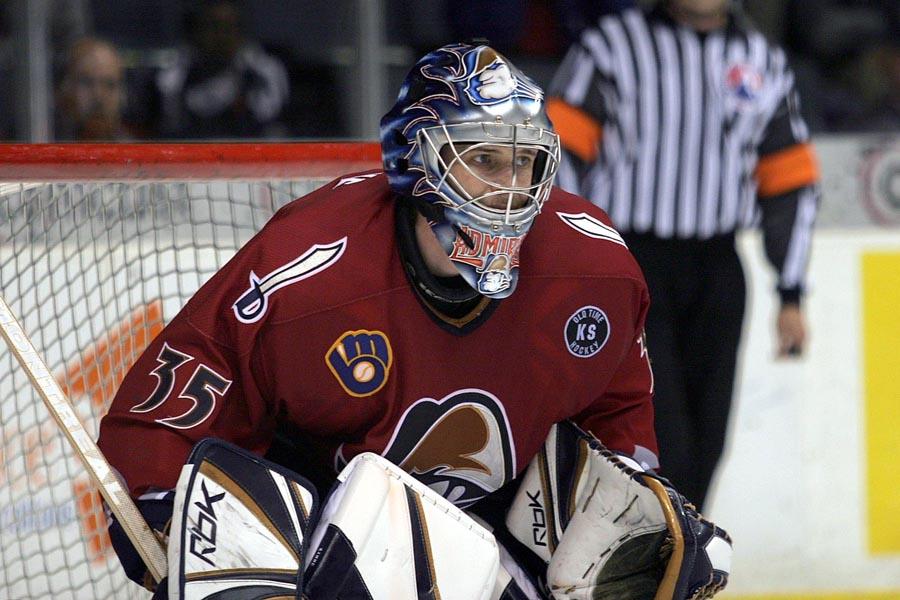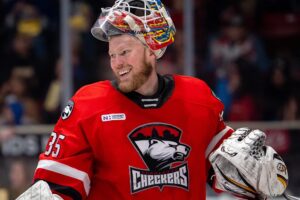by Jason Karnosky || AHL On The Beat Archive
When it comes to preparing players for the National Hockey League, the Milwaukee Admirals have few peers among their AHL brethren.
The Admirals’ parent club, the Nashville Predators, currently features five players — Nick Spaling, Blake Geoffrion, Matt Halischuk, Jonathon Blum and Anders Lindback — who have laced up their skates for Milwaukee at some point this season. Another 12 Predators — Pekka Rinne, David Legwand, Cal O’Reilly, Jerred Smithson, Colin Wilson, Martin Erat, Patric Hornqvist, Jordin Tootoo, Cody Franson, Kevin Klein, Ryan Suter and Shea Weber — have all put on an Admirals jersey at some point in their careers.
These skaters, combined with a flock of others who have found successes with other franchises, know just how important the time they spent in Milwaukee was to their future of their careers.
“Coming out of juniors, I thought I was ready for the NHL,” Weber said. “(But) going to Milwaukee was a big stepping stone, allowing me to adjust to the professional game and get used to playing against guys who were a lot bigger and stronger.”
Predators starting goaltender Pekka Rinne is perhaps the best example of a top-flight NHL player who honed his skills with the Admirals. After arriving in Nashville in the fall of 2005, Rinne spent three seasons improving his game in Milwaukee. Rinne accumulated 81 wins in 145 contents with the Admirals, while patiently waiting for his NHL opportunity behind netminders Tomas Vokoun, Chris Mason and Dan Ellis.
In 2008-09, Rinne caught on full-time with the Predators and has since become one of the game’s elite goaltenders, racking up 86 wins, a 2.34 goals-against average and a .919 save percentage in 164 NHL contests.
After just one year at the University of Wisconsin, Ryan Suter spent a season in Milwaukee during the NHL’s lockout in 2004-05. However, the jump to the professional ranks proved a significant adjustment for the defenseman, who needed the year to prep his game for the NHL level under the watchful eye of the Nashville brass.
“Because of the lockout the AHL was full of the NHL’s top young players, which made for a really competitive league that was a lot of fun to play in,” Suter said. “But that season I (also) got a lot of advice and guidance from the Predators organization because they were able to watch most of our games.”
Suter managed seven goals and 23 points during his year in Milwaukee, helping the Admirals to a 49-win season. But what Suter enjoyed the most about his time in the AHL was being able to play so close to his hometown of Madison.
“(Milwaukee) was a great place to start my professional career, especially being an hour down the road from home,” Suter said. “I grew up a big Admirals fan and attended a lot of their games as a kid, so it was a great experience to play there.”
Since his time in Milwaukee, Suter evolved into Nashville’s top defensive player, leading the Predators as a plus-24 this season while logging the second most minutes on the team (25:11 per game). Only Suter’s blueline partner, captain Shea Weber, logs more ice.
Weber, who is now the face of the Predators, was also a Milwaukee product. The defenseman skated in 46 contests with the Admirals during the 2005-06 season. Under the guidance of then coach Claude Noel, Weber fine tuned some his game’s rough edges in Milwaukee.
“My time in Milwaukee was huge for my career,” Weber said. “We had a great coaching staff with the Admirals, who helped me grasp what it meant to be a professional hockey player.”
Presently, Weber has become a budding superstar. The blueliner saw significant role on Canada’s gold medal winning Olympic team last February, and this January was named to his second straight All-Star team. This season Weber leads all Predators with 42 points in 68 games.
Weber’s 14 goals are tied for third on Nashville with center Colin Wilson, another Predators player who can trace his professional roots back to Milwaukee. Wilson saw action in 40 AHL contests with the Admirals last season before catching on with the Predators.
“When I first got down there, I wasn’t really paying attention to details in my game and instead was just thinking about offense,” Wilson said. “Playing in Milwaukee allowed me to develop my all-around game, but I worked a lot on my offensive skills as well.”
This year Wilson ranks tied for sixth on the Predators with 30 points.
All in all, Milwaukee alums represent 67.8 percent of the Predators’ offensive production this season, contributing 311 of the team’s 459 scoring points to date. And every one of Nashville’s 34 wins in 2010-11 was backstopped by a goaltender that at one point spent time playing for the Admirals.
But Milwaukee’s role in the development of NHL players does not just stop with Nashville. Several Admirals products have found career fulfillment with other organizations.
Mike Santorelli, older brother of Milwaukee forward Mark Santorelli, has emerged as an NHL regular with the Florida Panthers this season after spending three years working on his game under the guidance of Admirals coach Lane Lambert.
“(Mike) always had a tremendous skill set of offensive talents,” said Lambert of his team’s leading scorer from the past two seasons. “But he really developed his defensive game during the time he was here.”
Through 68 games with Panthers, Santorelli is Florida’s third-leading contributor with 17 goals and 34 points.
“Watching him this year, I’ve seen him take that (defensive) side of his game to another level,” Lambert said. “That used to be what held him back, but that isn’t the case anymore.”
Now skating for the Boston Bruins, forward Rich Peverley found great success after playing nearly three full seasons in Milwaukee from 2005-08. During those years, Peverley saw 46 games of action with the Predators before moving on to a fulltime NHL career with the Atlanta Thrashers.
“(Rich) reminds me a lot of Mike Santorelli,” Lambert said. “Both guys have a lot of skill, but both needed time in the American Hockey League to develop their overall game. Their commitment to making those adjustments made the difference in both players becoming fulltime NHL hockey players.”
After two seasons of being a fan favorite in Milwaukee, defenseman Sheldon Brookbank found a place in the NHL with the New Jersey Devils and more prominently with the Anaheim Ducks. Brookbank now has 186 games of NHL experience, scoring 22 points while racking up 315 minutes in penalties.
“I’ve always said that Milwaukee was one of my favorite places to play,” Brookbank said. “The fans were good, it was a good city to live in and there’s a little bit of history playing with an organization that’s been around for while.”
Brookbank spent two seasons with the Admirals from 2005-07. During 2006-07, Brookbank emerged as Milwaukee’s third leading scorer, contributing 15 goals and adding 38 assists for 53 points.
“I was given a lot of opportunities in Milwaukee to develop my game and get it to where it needed to be,” Brookbank said. “It was big for me to gain the confidence in myself necessary to move on to the next level.”
Whether a player went on to a successful NHL career with Nashville or with another organization, it’s hard to underestimate what the Milwaukee Admirals meant to the development of every skater who once got dressed at the Bradley Center. But for all of the players who once proudly put on an Admirals jersey, whether it was for three games or for multiple seasons, there is a sense of thanks for what Milwaukee meant to their hockey futures.
“While I was there I played with a lot great young players, like Shea Weber, Pekka Rinne and others,” Brookbank said. “Players develop well there, so Milwaukee really knows what it’s doing when it comes to preparing players for the next level.”






































